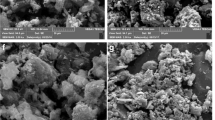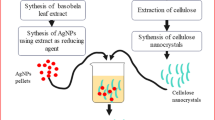Abstract
An optimization of coagulation and flocculation of kaolin suspension by a newly synthesized quaternized oil palm empty fruit bunch cellulose denoted as a 9QC was investigated using the central composite design of the response surface methodology. The influences of coag-flocculant dosage, pH, and kaolin suspension on turbidity removal efficiency and sludge volume index responses were studied and assessed according to a 23 full factorial design. The developed quadratic models revealed that the overall optimum values to obtain the highest performance of the responses were 62.5 mg/L of coag-flocculant dosage, pH 7, and 1400 mg/L of kaolin concentration. The predicted optimum responses were found to be in close proximity to the observed responses. The coag-flocculating of river water using 9QC carried out at the optimum values showed encouraging results as compared to alum which is commonly used in drinking water treatment process.




Similar content being viewed by others
References
Abdel-Halim ES, Al-Deyab SS (2011) Removal of heavy metals from their aqueous solutions through adsorption onto natural polymers. Carbohydr Polym 84:454–458
Al-Hamadani YAJ, Yusoff MS, Umar M, Bashir MJK, Adlan MN (2011) Application of psyllium husk as coagulant and coagulant aid in semi-aerobic landfill leachate treatment. J Hazard Mater 190:582–587
Alias N, Ibrahim N, Abd. Hamid MK, Hasbullah H, Ali RR, Md. Kasmani R (2015) Investigation of oil palm wastes’ pyrolysis by thermo-gravimetric analyzer for potential biofuel production. Energy Proc 75:78–83
Alkasrawi M, Al-Hamamre Z, Al-Shannag M, Abedin MJ, Singsaas E (2016) Conversion of paper mill residuals to fermentable sugars. BioResources 11(1):2287–2296
Bani-Melhem K, Al-Qodah Z, Al-Shannag M, Qasaimeh A, Qtaishat MR, Alkasrawi M (2015) On the performance of real grey water treatment using a submerged membrane bioreactor system. J Membr Sci 476:40–49
Birkner FB, Morgan JJ (1968) Polymer flocculation kinetics of dilute colloidal suspensions. J Am Water Works Assoc 60(2):175–191
Bolto B, Gregory J (2007) Organic polyelectrolytes in water treatment. Water Res 41:2301–2324
Cornell JA (1990) How to apply response surface methodology, 2nd edn. American Society for Quality Control, Statistics Division, ASQC, Milwaukee
Devrimci HA, Yuksel AM, Sanin FD (2012) Algal alginate: a potential coagulant for drinking water treatment. Desalination 299:16–21
Gurram R, Al-Shannag M, Knapp S, Das T, Singsaas E, Alkasrawi M (2016) Technical possibilities of bioethanol production from coffee pulp: a renewable feedstock. Clean Technol Environ Policy 18:269–278
Haaland PD (1989) Experimental design in biotechnology. Markel Dekker, New York
Ives KJ, Al Dibouni M (1979) Orthokinetic flocculation of latex microsphere. Chem Eng Sci 34:983–991
Jain R (2011) Drinking water security and sustainability. Clean Technol Environ Policy 13:215–216
Jain R (2012) Providing safe drinking water: a challenge for humanity. Clean Technol Environ Policy 14:1–4
Kamide K (2005) Cellulose and cellulose derivatives. Elsevier B.V., Amsterdam
Kennish MJ (1997) Practical handbook of estuarine and marine pollution. CRC Press, Boca Raton
Khuri AI, Mukhopadhyay S (2010) Response surface methodology. WIREs Comput Stat 2:128–149
LaMer VK, Healy TW (1964) The energetics of flocculation and dispersion by polymer. J Coll Sci 19:323–332
Lee S, Robinson J, Chong MF (2014) A review on application of flocculants in waste water treatment. Process Saf Environ 92(6):489–508
Machida S, Narita H, Katsura T (1971) Flocculation properties of cellulose-acrylamide graft copolymers. Angew Makromol Chem 20:47–56
Mason RL, Gunst RF, Hess JL (2003) Statistical design and analysis of experiments: with applications to engineering and science, 2nd edn. Wiley, Hoboken
Matilainen A, Vepsäläinen M, Sillanpää M (2010) Natural organic matter removal by coagulation during drinking water treatment: a review. Adv Colloid Interface Sci 259(2):189–197
Mohtar SS, Tengku Malim Busu TNZ, Md Noor AM, Shaari S, Yusoff NA, Mat H (2016) Ionic liquid isolation and modification of cellulose derived from oil palm empty fruit bunches towards preparation of coag-flocculants for drinking water treatment application. Clean-Air WaterSoil (submitted for possible publication)
Muyibi SA, Evison LM (1995) Optimizing physical parameters affecting coagulation of turbid water with Moringa oleifera seeds. Water Res 29(12):2689–2695
Nourani M, Baghdadi M, Javan M, Bidhendi GN (2016) Production of a biodegradable flocculant from cotton and evaluation of its performance in coagulation–flocculation of kaolin clay suspension: optimization through response surface methodology (RSM). J Environ Chem Eng 4(2):1996–2003
Özacar M, Şengil IA (2003) Effect of tannins on phosphate removal using alum. Turk J Eng Environ Sci 27:227–236
Renault F, Sancey B, Badot PM, Crini G (2009) Chitosan for coagulation/flocculation processes-An eco-friendly approach. Eur Polym J 45:1337–1348
Roy PK, Majumder A, Banerjee G, Roy MB, Pal S, Mazumdar A (2015) Removal of arsenic from drinking water using dual treatment process. Clean Technol Environ Policy 17(4):1065–1076
Sanz-Medel A (1998) Toxic trace metal speciation: importance and tools for environmental and biological analysis. Pure Appl Chem 70:2281–2285
Shi Y, Ju B, Zhang S (2012) Flocculation behavior of a new recyclable flocculant based on pH responsive tertiary amine starch ether. Carbohydr Polym 88:132–138
Spellman FR (2009) Handbook of water and wastewater treatment plant operations, 2nd edn. CRC Press, Taylor and Francis Group, Boca Raton, USA
Sun RC, Sun XF (2002) Fractional and structural characterization of hemicelluloses isolated by alkali and alkaline peroxide from barley straw. Carbohydr Polym 49(1):415–423
Tzoupanos ND, Zouboulis AI (2008) Coagulation flocculation processes in water wastewater treatment: the application of new generation of chemical reagents. In: 6th IASME/WSEAS international conference on heat transfer, thermal engineering and environment (HTE’08), August 20th–22nd, Rhodes, Greece, pp 309–317
Wang Y, Chen K, Mo L, Li J, Xu J (2014) Optimization of coagulation–flocculation process for papermaking-reconstituted tobacco slice wastewater treatment using surface response methodology. J Ind Eng Chem 20(2):391–396
Xiong C, Yao C (2009) Synthesis, characterization and application of triethylenetetramine modified polystyrene resin in removal of mercury, cadmium and lead from aqueous solutions. Chem Eng J 155:844–850
Zhu H, Zhang Y, Yang X, Liu H, Zhang X, Yao J (2015) An eco-friendly one-step synthesis of dicarboxyl cellulose for potential application in flocculation. Ind Eng Chem Res 54:2825–2829
Acknowledgments
The financial supports from: the Ministry of Higher Education (MOHE), Malaysia for the MyBrain15 scholarship, and the Ministry of Science, Technology and Innovation (MOSTI), Malaysia, for the eScience Fund (Project No. 03-01-06-SF114/4S071) are gratefully acknowledged. The technical supports from the Syarikat Air Johor (SAJ) Sdn. Bhd. (Johor, Malaysia) and Indah Water Konsortium (IWK) Sdn. Bhd. (Kuala Lumpur, Malaysia) are also gratefully acknowledged.
Author information
Authors and Affiliations
Corresponding author
Rights and permissions
About this article
Cite this article
Mohtar, S.S., Tengku Malim Busu, T.N.Z., Md. Noor, A.M. et al. Optimization of coag-flocculation processes of a newly synthesized quaternized oil palm empty fruit bunch cellulose by response surface methodology toward drinking water treatment process application. Clean Techn Environ Policy 19, 191–204 (2017). https://doi.org/10.1007/s10098-016-1221-0
Received:
Accepted:
Published:
Issue Date:
DOI: https://doi.org/10.1007/s10098-016-1221-0




